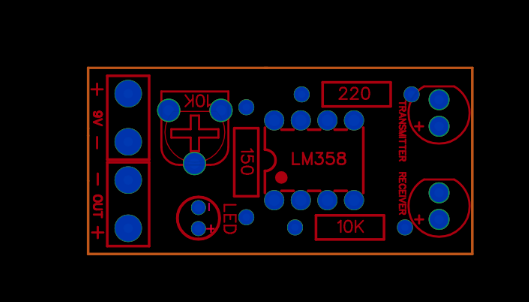A proximity sensor is an instrument which identifies the existence or non-existence of surrounding items from a distant point without having to make physical contact with them; it operates through emitting electromagnetic fields or electromagnetic radiations beams before detecting alterations in these emissions emanating from the existence of an item.
They improve safety, productivity, and convenience by enabling automation and touchless interaction. For instance, in a call, a smartphone’s screen can be turned off when it is brought close to the user’s face by proximity sensors found on smartphone devices. In automotive systems, the proximity sensors are frequently used to help in parking as well as avoid collision. For object detection purposes and automation, proximity sensors are installed in industrial machinery. There are also those present in households appliances (automatic faucets as well as hand dryers).
Component Used
- LM358
- 10k ohm resistor
- 220-ohm resistor
- IR Receiver
- IR Transmitter
- Buzzer
- 9V Battery
- 10K Potentiometer
- Battery cap
- 120 ohm Resistor
- LED
Special Thanks to Our Sponser – JLCPCB:
No project is complete without the right tool and materials. That’s why our sponser JLCPCB stepped into provide essential material for the project. JLCPCB is a leading provider of high quality printed circuit board and PCB assembling services.
Simply head over to JLCPCB, Upload your gerber file, select specification and just place your order.
48-Hour Turnaround for 6 Layer PCBs!

$0 for 2u” ENIG. Free Via-in-Pad. High Precision. Sign Up to Get $80 New User Coupons.

How To Order PCB
Gerber file


Download Gerber File
Uses of Proximity Sensor
Proximity sensors have many uses across different industries and applications due to their capability of detecting objects without touching them. This is illustrated below:
- Smartphones
- Automotive
- Industrial Automation
- Robotics
- Household Appliances
- Security Systems
- Medical Devices
- Gaming
LM 358:
The LM358 is a popular and widely used integrated circuit (IC) in the world of electronics. It is a dual operational amplifier (op-amp), which means it contains two independent op-amps in a single package. Due to its versatility, low cost, and availability, the LM358 is often found in both hobbyist and professional electronic projects.
The LM358 is a dual op-amp IC that belongs to the LM series of operational amplifiers produced by Texas Instruments and other manufacturers. An op-amp is a high-gain electronic voltage amplifier with a differential input and typically a single-ended output. It can be used in various analog circuits, such as amplifiers, filters, oscillators, and more.
The LM358 features:
- Dual op-amps: The LM358 contains two op-amps, which makes it convenient for designs that require multiple amplifiers.
- Low Power Consumption: The IC operates at a lower supply voltage, usually between 3V to 32V, which is ideal for low-power applications.
- Single Supply Operation: It works with a single power supply, which makes it easier to design with when you don’t need a dual supply.
- Wide Voltage Range: The LM358 can work with a wide input voltage range and provides reliable performance under various conditions.
Key Specifications
- Supply Voltage: 3V to 32V (Single supply) or ±1.5V to ±16V (Dual supply)
- Input Voltage Range: Can handle input voltages from ground (0V) to the positive supply rail.
- Output Voltage Swing: The output can swing from the negative rail to just a few volts below the positive rail.
- Bandwidth: It has a gain-bandwidth product of about 1 MHz, which is quite adequate for most applications.
- Output Current: The typical output drive current is 20 mA, making it useful for driving low-power devices directly.
The LM358 is a reliable, affordable, and versatile operational amplifier that is ideal for a wide range of analog applications. Whether you’re building audio amplifiers, filters, voltage followers, or sensor signal conditioning circuits, the LM358 is a solid choice. Its ease of use, low power consumption, and dual op-amp configuration make it a go-to component for both beginners and experienced engineers.
If you’re working on a project and need a simple and efficient op-amp, the LM358 is a great IC to consider. Its flexibility allows you to design circuits for various purposes, helping you bring your ideas to life.
More Projects
-
Meet the Cutebot Pro – The smartest Micro:bit Robot Car!
The CuteBot Pro is a programmable robot-car kit designed for STEAM/robotics education.Key features include: Obstacle Avoiding Car Line Following Car More Projects
-
Create a Stunning Heart LED chaser Circuit with Simple Electronics
An LED chaser is an electronic circuit that lights LEDs one after another in a sequence. It creates a running or chasing light effect commonly seen in decorations and indicators. …
-
Amazing LED Chaser Circuit – Beautiful Decoration Idea
An LED chaser is an electronic circuit that lights LEDs one after another in a sequence. It creates a running or chasing light effect commonly seen in decorations and indicators. …



